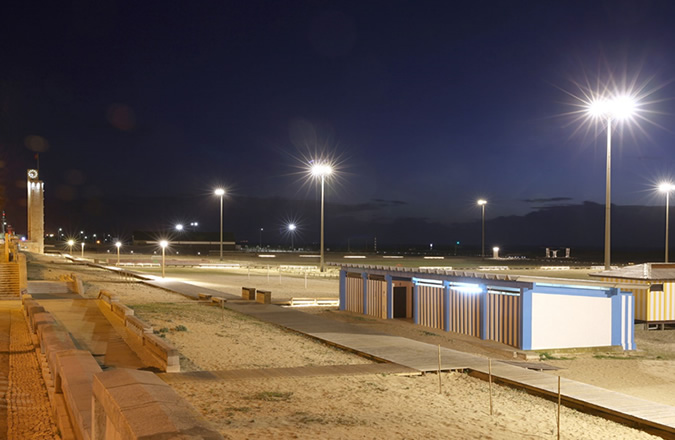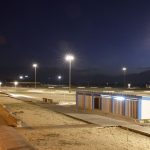
Figueira da Foz beach
Avento luminaires with Owlet IoT create a warm nocturnal landscape for Figueira beach with more than an 83% reduction in energy savings and CO2 emissions
The large, sandy beach of Praia da Figueira is a real gem on Portugal’s south coast, attracting a vibrant holiday crowd all year long. It is very popular with surfers and people wanting to play sand sports or simply admire the stunning sunsets.
In 2017, the local authorities launched the “Figueira Beach Sports City” project to maximise the potential of this beach, which is the largest in Europe, and make it the “go to beach” for sand sports. Special areas have been dedicated to rugby, volleyball or beach football, for leisure or competitions.
To ensure a safe and pleasant nocturnal environment, the local authorities decided to replace the lighting on the beach, which was lit by floodlights fitted with traditional discharge lamps (2000W).
The new luminaires would not only have to provide excellent visibility with high visual comfort but also demonstrate a strong resistance to the harsh coastal environment and be managed by a control system to optimise the installation lifecycle and significantly reduce energy and maintenance costs.
They chose the Avento luminaire managed by the Owlet IoT control system.
The Avento, composed of aluminium and glass and fitted with the Schréder MidFlex™ photometric engine, guarantees long-term photometric and mechanical performance.
With an advanced plug and play commissioning system, Owlet IoT enables adaptive scenarios from anywhere at anytime using an internet-connected device. The luminaires can be switched on/off or the lighting levels adapted to events taking place on the beach. Real-time notifications and clear reports will ensure an efficient operation of the entire network and optimise maintenance work.
The Avento luminaires (200W) provide an average illuminance of 40 lux and overall uniformity of more than 50% in line with the lighting requirements while reducing energy consumption by a staggering 83%.
The Owlet IoT system will enable the city to further optimise energy consumption and maintenance, leading city officials to estimate energy savings of close to 90%!
The Avento luminaires direct the light to the front of the beach where the activities take place to reduce light trespass in the water and protect sea life.
The new lighting is nothing but good for the city as it will reduce energy use, lower costs and cut pollution.
Residents and tourists will be able to benefit from these additional nocturnal spaces, which in turn will breathe new economic and cultural life into the local economy.
